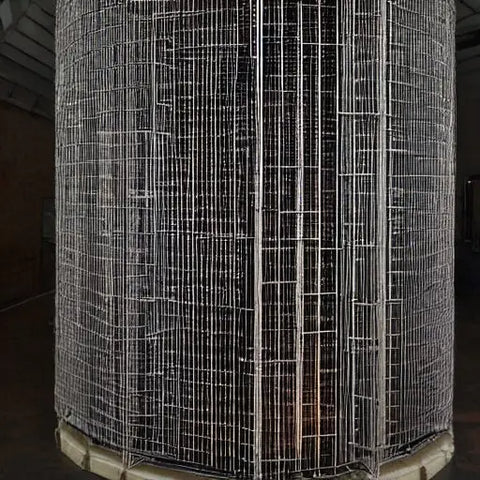What is a Faraday Cage?
What exactly is a Faraday Cage used for?
A device known as a faraday cage is one that protects the electromagnetic field of a device by being constructed out of conductive materials and having the shape of a cage. It is possible that the conductive material will be arranged in the form of a continuous covering or it may be arranged in the form of a mesh structure. Michael Faraday, a scientist, is credited with inventing the apparatus around the year 1836.
The following is a list of some of the components that make up a Faraday cage:
- In most cases, a Faraday cage is constructed out of a conductive substance, like metal, that is able to either block electromagnetic fields or absorb their energy.
- In order to give total protection from electromagnetic fields, a Faraday cage is normally enclosed on all sides, including the top and the bottom.
- A Faraday cage may take on a variety of configurations and dimensions, depending on the use for which it was designed and the dimensions of the items or apparatus that it is meant to shield.
- It is possible for a Faraday cage to have apertures or holes in its walls; however, they should be sufficiently tiny to prevent electromagnetic fields from passing through them.
- If you want to further improve the Faraday cage's ability to block electromagnetic radiation, you may outfit it with grounding straps or cables.
- Electronic and electrical devices may be shielded from the damaging effects of electromagnetic pulses (EMPs), radio frequency interference (RFI), and other sources of electromagnetic fields (EMFs) with the assistance of a Faraday cage.
Putting a Faraday cage in the ground
A Faraday cage, also known as a shielded enclosure, is a metal box or enclosure that is meant to separate electronic equipment from electromagnetic fields. Another name for a Faraday cage is an electrostatic field barrier. It offers defense against the threat posed by an electromagnetic pulse, often known as an EMP. This has the potential to render electrical devices, such as computer chips and mobile phones, inoperable.
In order for a Faraday cage to perform its intended purpose, the cover must be shielded from the metal enclosure's outside. An excellent Faraday cage might be constructed with nothing more than an aluminum bucket fitted with a cover that is airtight. Nevertheless, heavy-duty copper foil is the material that comes to mind first.
Constructing a metal box with a conductive shell is yet another alternative that may be considered. Aluminum tape may be used to wrap the lid if desired. An alternative option for constructing a Faraday cage is to use a galvanized bucket. There are also more choices available, such as using chicken wire.

A Faraday cage is constructed using two ground planes and a variety of vias that link them. The purpose of these planes and vias is to stop the coupling of digital noise into the analog signal line. The difference in voltage between the signal and the potential voltage that would be produced by a power grid may be minimized by connecting the signal wires to a shared common. In the event that a parallel signal line were to cut through the ground plane, the signal would be deflected away from the path it was supposed to take.
A typical cage will simply encircle an item; however, a Faraday cage will entirely contain whatever it is that it is protecting. To further enhance the safety afforded by the cage, you may even build more conductor layers inside of it.
Even if EMP is a genuine phenomenon that poses a risk, you may still protect your electronic devices from damage by taking a few elementary steps. Even while most contemporary vehicles, like as automobiles, aren't especially vulnerable to the danger, you should still think about purchasing a Faraday cage in order to secure your computer and any other electrical devices you may have.
You don't need a Faraday cage to protect your connection from being disrupted by an electromagnetic pulse, however. When it comes to the charging component of the issue, you also have the option of using a solar charger.
In the event that you need to shield your electrical devices from the effects of an EMP, the first step you should do is to disable all of your antennas. In addition to that, you need to make sure that every one of your power wires is tucked away somewhere. In addition to this, you need to make sure that every piece of equipment that you need to maintain is stored in its own individual Faraday cage.
When constructing a Faraday cage, it is important to pay close attention to the dimensions of the signal wires as well as the placement of the vias. In a perfect world, the signal lines would not be arranged such that they ran parallel to the ground planes. In regard to the vias, they have to be consistently placed around the perimeter of the ground planes in order to minimize the interference that is caused by other signals.
Conductive tape may be applied to any holes in a Faraday cage in order to increase its performance, which is another technique to improve its effectiveness. To do this, you will need to apply conductive tape at a location that is as close to the signal lines as is practically practicable.
Conducting Tests on a Faraday Cage
Your electronic equipment may be protected against electromagnetic pulses (EMP) and solar flares by using a cage called a Faraday cage. In spite of its name, a Faraday cage is not always the most effective method for safeguarding your apparatus. Nevertheless, when there are potentially dangerous events happening in the globe, it is prudent to place your equipment in a Faraday cage. Faraday cages, in contrast to microwave ovens, which provide incredible amounts of shielding at microwave frequencies, are not entirely closed enclosures. They are able to function because an external electric field is used to coerce the conductive material contained inside the cage to travel to the other side of the enclosure, which results in the external field being cancelled out.
When Michael Faraday initially thought of the electromagnetic field in the 1800s, he also came up with the idea of a Faraday cage to contain electromagnetic fields. Electronics and computer laboratories utilize Faraday cages to shield sensitive electronic equipment from the harmful effects of electromagnetic radiation in today's world.
The shape of the conductive material that makes up a Faraday cage is one of the most crucial aspects in determining how efficient the cage will be. If the geometry is too extensive, the charge may not be redistributed correctly, which would result in a field that was not cancelled out. In a similar vein, a conducting material with a higher resistance leads to a delayed redistribution, which results in a field that is not cancelled out.
As a consequence of this, you want to make certain that the cage you use is of high quality. It need to have a cover, doors, or a port of entrance at the very least. Additionally, the outside of your enclosure need to be insulated, and the inside ought to be coated with a conductive material. Because of this, electromagnetic energies will not be able to pass through the enclosure, and the wavelengths that are able to do so will be altered.

Copper or aluminum foils are the materials of choice for constructing a Faraday cage. An improvised "Faraday cage" may be constructed out of any metallic container, such as a box, a refrigerator, or a freezer. You may also create a shield by encasing your laptop or another sensitive equipment in aluminum foil and wrapping it around yourself.
In the process of creating a Faraday cage, it is essential to make certain that there is a means by which the cage can be accessed for the purposes of testing. In order to activate some equipment, such as a cocktail shaker, a signal is necessary. Be certain that the cage has a ground reference, which may take the form of either a metal lug or a floating ground lead.
Experiments in electrochemistry that employ a Faraday cage need a high degree of precision; however, achieving this level of precision is impossible unless the potentiostat is properly grounded. The elimination of noise is another important consideration for low-current measuring systems.
The science of EMP grounding stands on its own as a discipline. It is not difficult to forecast when and how EMPs will occur since there are a number of different methods in which they may be produced. According to Pry, a member of the National and Homeland Security Task Force on EMPs, in the event that an EMP event takes place, ninety percent of Americans would perish. To protect yourself against this, it is recommended that you remove all antennas and power cables from your equipment and then keep it in a Faraday cage.
In a wide variety of contexts, Faraday cages are helpful. During a solar flare, you may use a Faraday cage to protect sensitive electronic equipment from outside radio frequency interference, or you could use it to store valuables to protect them from the radiation.
Keeping Away From The Disturbance of a Faraday Cage
An electromagnetic interference (EMI) barrier, often known as a Faraday cage, is a metal enclosure that helps protect sensitive electronic equipment from being disrupted by EMI. The cage performs the function of a hollow conductor, preventing electric charge from being absorbed by your circuits. Additionally, it eliminates the chance of a single conductive substance absorbing the whole electric field since it equally distributes the electrical charge across the cage. Because of this, the cage is an essential component for any system that has several printed circuit boards or numerous massive components.
The usage of Faraday cages is helpful for avoiding side-channel assaults, which take place when radio frequencies released by a nearby device interfere with the capacity of your antenna to pick up the signal being sent by another device. They may also serve as a shield against the effects of lightning. It is essential to keep in mind, however, that even Faraday cages do not entirely block everything. They may still let some radio frequency (RF) waves to travel through them, but this will depend on the materials that were used to make them. For illustration's sake, the frequency at which a home microwave works is 2.4 GHz. Despite the fact that this is a very low frequency, there is still enough of it to pose some issues.
In order to give protection against electromagnetic pulses, which are naturally occurring electromagnetic fields, another reason to employ a Faraday cage is to contain the electromagnetic fields. These fields are not harmful in and of themselves, but if they find their way into a sensitive electrical device, they might cause it to malfunction. Constructing a Faraday cage using a material that emits little or no radiation is the best way to prevent this from happening.

Mesh or sheet copper are the most common materials used in the construction of Faraday cages. In order to stop EMI from penetrating the circuit, the conductor, no matter what kind it is, has to be rather substantial and highly conductive. If you want to build your own Faraday cage, you should bear the following things in mind:
You will need to calculate the wavelengths of the radiation that will be allowed to enter your enclosure while it is shielded. There are certain Faraday cages that have extremely narrow entryways; however, if you are searching for the highest level of security, you should choose a cage that has a very broad diameter. Alternately, if you are going to utilize a mesh cage, the holes in the mesh should be no larger than the wavelength of the radiation that will be passing through it. Although there is a possibility that this will not function well at a higher frequency, doing so will assist to lessen the interference in general.
There are three different methods that contribute to EMI. It is possible for it to originate from the internal circuitry of a device, from the environment that the device is located in, or from an external source. Your system's overall performance may suffer if any of these three factors are present. All of these potential dangers can be eradicated if one has access to a Faraday cage.

To stop electromagnetic interference from entering or escaping the enclosure, the conductive material of the cage has to be of sufficient thickness. It need to be able to tolerate a voltage of 1700 VDC without being damaged. The ideal version of the cage would have a robust and solid metal exterior. Solid cages are superior than mesh cages when it comes to the ability to attenuate a wider spectrum of frequencies.
You may get a Faraday cage with the use of the internet if you need one. However, it is essential to keep in mind that plastic enclosures do not inherently provide any protection against electromagnetic interference (EMI).


































Leave a comment